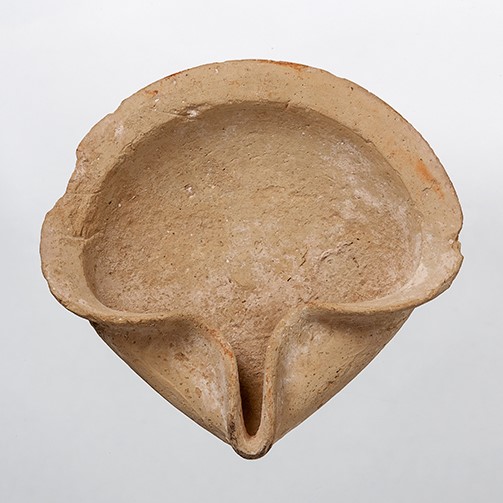Title: Cypriot Open Lamp - 1973.30
Acquisition number: 1973.30
Author or editor: J.R. Green
Culture or period: Pre-Classical Cypriot.
Date: 6th century BC.
Material: Clay - Terracotta
Object type: Lamps - Terracotta
Dimensions: 121mm (w) × 38mm (h)
Origin region or location: Cyprus
Display case or on loan: 3
Keywords: Cypriot, Archaic, Lamp
Charles Ede Ltd (London), Catalogue 90 (March 1973) no. 38b; J.R. Green with B. Rawson, Catalogue of Antiquities in the Australian National University, A.N.U. (Canberra, 1981) 79; Webb no. 225, pl. 17.
1973.30
Cypriot Open Lamp
Purchased. Ht of spout 3.8cm; max.diam. 12.1cm.
Wheelmade open lamp, intact but for some chips from the lip. Cream-grey clay with many white inclusions. Flat cut-away base; the lip is offset and the edges folded in at one side to form a wick-rest. This rest shows traces of burning.
Although lamps were known in Greek lands in the Bronze Age, they dropped out of use with the end of Mycenaean culture. They remained in use in the Eastern Mediterranean, however, and it was from there that the revival of their use came in the developed Iron Age. In Cyprus this cocked hat version (clearly a simple dish with the lip pulled into a spout on one side) first appears some time in Cypriot Geometric III, that is between 850 and 700 BC, although greater precision is not yet possible; cf. Swedish Cyprus Expedition IV.2, 169-17l and 223. The type lasted there long after it had been superseded in Greece and is not uncommon even in Hellenistic times. In Greece one of the earliest securely dated examples of this type was found in the University of Sydney’s excavations of the settlement at Zagora on the island of Andros in a context datable to the very end of the eighth century BC. It is as yet unpublished. The pronounced rim on the lip of our example suggests that it cannot be among the earliest. Compare J.L. Benson, The Necropolis of Kaloriziki (Studies in Mediterranean Archaeology 36, Lund 1973) 127 and pll. 41, K 1149-1151, and 55, K 1155; also T. Oziol, Salamine de Chypre VII. Les lampes du Musée de Chypre (Paris 1977) pll. 1-3 and 52-53; D.M. Bailey, A Catalogue of the Lamps in the British Museum, i, Greek, Hellenistic, and Early Roman Pottery Lamps (London 1975) pll. 96-97, with discussion at pp. 207-210 and 221-225.
See also E. Parisinou, “Lighting Practices in Early Greece”, Oxford Journal of Archaeology 17, 1998, 327-343.
Cypro-Archaic; probably sixth century BC. Note also the series of lamps of this kind but with double wick-rest in the collection of material from Malta catalogued above.
Charles Ede Ltd (London), Catalogue 90 (March 1973) no. 38b; J.R. Green with B. Rawson, Catalogue of Antiquities in the Australian National University, A.N.U. (Canberra, 1981) 79; Webb no. 225, pl. 17.
